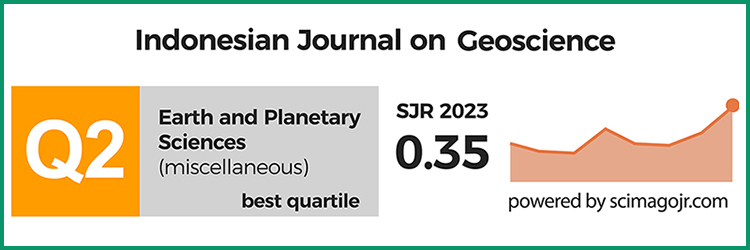Geology and Characteristics of Pb-Zn-Cu-Ag Skarn Deposit at Ruwai, Lamandau Regency, Central Kalimantan
DOI:
https://doi.org/10.17014/ijog.6.4.191-201Keywords:
skarn deposit, mineralogy, geochemistry, Ruwai, Central KalimantanAbstract
This study is dealing with geology and characteristics of mineralogy, geochemistry, and physicochemical conditions of hydrothermal fluid responsible for the formation of skarn Pb-Zn-Cu-Ag deposit at Ruwai, Lamandau Regency, Central Kalimantan. The formation of Ruwai skarn is genetically associated with calcareous rocks consisting of limestone and siltstone (derived from marl?) controlled by NNE-SSW-trending strike slip faults. It is localized along N 70° E-trending thrust fault, which also acts as the contact zone between sedimentary and volcanic rocks in the area. The Ruwai skarn is mineralogically characterized by prograde alteration comprising garnet (andradite) and clino-pyroxene (wollastonite), and retrograde alteration composed of epidote, chlorite, calcite, and sericite. Ore mineralization is typified by sphalerite, galena, and chalcopyrite, formed at early retrograde stage. Galena is typically enriched in silver up to 0.45 wt % and bismuth of about 1 wt %. No Ag-sulphides are identified within the ore body. Geochemically, SiO is enriched and CaO is depleted in limestone, consistent with silicic alteration (quartz and calc-silicate) and decarbonatization of the wallrock. The measured resources of the deposit are 2,297,185 tonnes at average grades of 14.98 % Zn, 6.44% Pb, 2.49 % Cu, and 370.87 g/t Ag. Ruwai skarn orebody was originated at moderate temperatures of 250 - 266 °C and low salinity of 0.3 - 0.5 wt.% NaCl eq. The late retrograde stage was formed at low temperature of 190 - 220 °C and low salinity of ~0.35 wt.% NaCl eq., which was influenced by meteoric water incursion at the late stage of the Ruwai Pb-Zn-Cu-Ag skarn formation.
References
Ayson, J.N.R., 1997. PT. Tebolai Seng Perdana – Summary of exploration activities (preliminary report). PT. Tebolai Seng Perdana, Unpublished report, 56p.
Baratang, V.T., Jr., 1997. Report on the PT. Scorpion Schwaner Mineral Contract of Work – Ketapang and Sintang district, West Kalimantan and Kotawaringin Barat district, Central Kalimantan. Unpublished report, 13p.
Cooke, D.R. and Kitto, P.A., 1997. The mineral prospectivity of the Tebolai and Schwaner COW’s, Southwest Kalimantan, Indonesia. Internal report, 32p.
Hedenquist, J.W., Arribas, A., and Reynolds, T. J., 1998. Evolution of an intrusion-centred hydrothermal system far Southeast-Lepanto porphyry and epithermal Cu-Au deposits, Philippines. Economic Geology, 93, p.373-404. doi:10.2113/gsecongeo.93.4.373
Idrus, A., Kolb, J., Meyer, F.M., Arif, J., Setyandhaka, D., and Kepli, S., 2009. A Preliminary study on skarn-Related calc-silicate rocks associated with the Batu Hijau porphyry copper-gold deposit, Sumbawa Island, Indonesia. Resource Geology, 59(3), p. 295-306. doi:10.1111/j.1751-3928.2009.00097.x
Kwak, T.A.P., 1986. Fluid inclusions in skarns (carbonate replacement deposits). Journal of Metamorphic Geology, 4, p. 363-384. doi:10.1111/j.1525-1314.1986.tb00358.x
Meinert, L. D., Hefton, K.K., Mayes, D., and Tasiran, I., 1997. Geology, zonation and fluid evolution of the Big Gossan Cu-Au skarn deposit, Ertsberg mining district, Irian Jaya. Economic Geology, 92, p. 509-533. doi:10.2113/gsecongeo.92.5.509
Williams, H., Turner, F.J., and Gilbert, C., 1982 Petrography, an introduction to the study of rocks in thin sections. W.H. Freeman and Company, 626 p. doi:10.1002/gj.3350010315



















